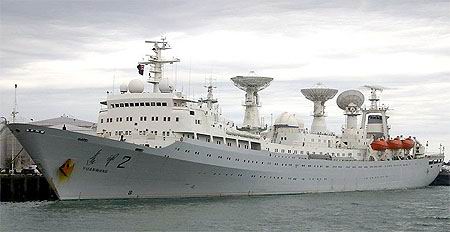| Yuanwang 1/2 Space Tracking Ships
中国远望1/2号航天测量船 Date:2009-10-26 Source:internet By:globalmil Viewed: |

In 1965, Premier Zhou Enlai first proposed the concept of China developing its own ocean-going space tracking ships. In July 1967, the Chinese leadership approved a large-scale shipbuilding project known as Project 718 to support China’s first full-range ICBM test flight from Shuang Cheng Zi missile test site in Northwest China to the target zone in the South Pacific. The project included two 21,000t missile and spaceraft tracking ships (Yuanwang 1 and 2), an ocean scientific survey ship (Xiangyanghong 10), and an ocean rescue ship (Dajiang class), all to be constructed by Jianan Shipyard in Shanghai.
在1965年,周恩来(Zhou Enlai)总理首次提议中国发展它自己的远洋航天测量船。在1967年7月,中国领导层核准一个大规模的造船计划即被称为718计划,去支援从位于中国西北的酒泉(Shuang Cheng Zi)导弹测试地点到南太平洋靶区的中国第一次全-射程洲际弹道导弹(ICBM)测试飞行。计划包含了二艘21,000吨导弹和航天测量船(远望(Yuanwang) 1号和2号),一艘海洋科学调查船(向阳红(Xiangyanghong) 10号) 和一艘海洋援救船(大江(Dajiang)级),全部由位于上海的江南(Jianan)造船厂建造。
The first missile and space tracking ship Yuanwang 1 was launched on 31 August 1977, followed by the second ship on 1 September 1978. In early 1980, a large naval task force consisting 20 surface ships departed from Shanghai to the South Pacific for the scheduled missile test. On 18 May 1980, a DongFeng-5 (CSS-4) ICBM was launched from Shuang Cheng Zi and the warhead was successfully recovered by the naval task force waiting in the target zone in the South Pacific.
第一艘导弹和航天测量船远望 1号在1977年8月31日下水,接着第二艘在1978年9月1日下水,在1980年初,一个大规模的海军特遣部队由20艘水上舰船组成从上海到南太平洋去为了预定的导弹测试。在1980年5月18日,东风(DongFeng)-5(CSS-4) ICBM从酒泉发射,而且弹头成功地被在南太平洋靶区等候的海军特遣部队回收了。
In the mid-1980s, Yuanwang 1 and 2 were also involved in the full-range test flight of the JuLang-1 (CSS-N-3) submarine-launched ballistic missile (SLBM) and the tracking of China’s first geostationary orbit communications satellite DFH-2 and the third-stage of its ChangZheng-3 launch vehicle. In 1986, the two ships received their first modernisation refit to support China’s commercial launch services for international customers. In the late 1990s, Yuanwang 1 and 2 received their second major refit to support the flight missions of China’s ShenZhou manned spacecraft.
在1980年中期,远望1号和2号也参加巨浪(JuLang)-1(CSS-N-3)潜射弹道导弹弹(SLBM)的全距离测试飞行和跟踪中国第一颗地球同步轨道通信卫星DFH-2号和搭载它的长征(ChangZheng)-3型三级运载火箭。在1986年,这二艘船接受它们的第一次现代化改装去支援来自国际客户的中国商业发射服务。在1990年后期,远望 1号和2号接受它们的第二次较大的改装去支援中国神舟(ShenZhou)有人操纵宇宙飞船飞行任务。
By 2005, Yuanwang 1 had successfully undertaken 41 voyages for 38 missile and satellite tracking missions, totalling some 1,500 days of operation in the sea and covering a total distance of 270,000 nautical miles. During the ShenZhou 5 manned space flight mission, Yuanwang 1 positioned in the Sea of Japan captured the spacecraft’s signal 9 minutes after its separation from the launch vehicle and commanded the spacecraft to deploy its solar panels. During the ShenZhou 6 flight mission, Yuanwang 1 positioned in the West Pacific captured the spacecraft signal only 31 seconds after its separation from the launch vehicle and successfully commanded the spacecraft to deploy its solar panels.
至2005年,远望 1号成功地为38枚导弹和卫星跟踪任务承担41次航行,在海洋中总计运转1,500天和覆盖总航程270,000海里。在神舟 5号有人操纵航天飞行任务期间,在它与运载火箭分离之后位于日本海中远望 1号9分钟后就捕获宇宙飞船的信号并且命令宇宙飞船展开它的太阳能帆板。在神舟 6号任务飞行期间,位于太平洋西部的远望 1号在它与运载火箭分离后仅仅31秒后就捕获宇宙飞船的信号并且成功地命令宇宙飞船展开它的太阳能帆板。
Yuanwang 2 is similar in size and performance to Yuanwang 1. However, unlike Yuanwang 1, which is normally positioned near the Chinese coast, Yuanwang 2 has been positioned in the South Pacific. By 2005 the ship had covered a total distance of 400,000 nautical miles in 31 missions, and was frequently spotted in foreign seaports. During the ShenZhou flight missions, the ship was responsible for commanding the spacecraft to enter its initial orbit after being separated from the launch vehicle.
远望 2号在尺寸和性能方面类似远望 1号。然而,不像远望 1号,通常在中国海岸附近部署,远望 2号在南太平洋部署。至2005年该船在31个任务中覆盖全航程400,000海里,而且时常在国外海港被看见。在神舟任务飞行期间,该船负责指挥宇宙飞船在和运载火箭分离之后进入它的起始轨道。
Mission Equipment
The ships are fitted with C- and S-band monopulse tracking radar, Cinetheodolite laser ranging and tracking system, velocimetry system, and onboard computers to track and control the spacecraft. They use a combination of inertial, satellite, and stellar for accurate navigation and positioning. Communications include HF, ULF, UHF, and SATCOM, in the form of secured telephone, radio, fax and data link. The ships are also equipped with a range of weather forecasting equipments including weather radar, sonde, and weather balloon, meteorological satellite image receiving terminal.
任务设备
船上配备有C-和 S-波段单脉冲跟踪雷达、激光测距经纬仪和跟踪系统、测速系统和舰载计算机去跟踪并控制宇宙飞船。它们使用组合惯性、卫星和星形用于精确导航和定位。通信包括HF、ULF、UHF和SATCOM,采用保密电话,传真和数据链形式。船上也被装备多种天气预报设备包括气象雷达、探测器和气象气球,气象卫星图像接收终端机。
Shiplist
| Name | Launch | Commission |
| Yuanwang 1 | 31 Aug 77 | Dec 79 |
| Yuanwang 2 | 1 Sept 1978 | ? |
船只目录
名称 下水 服役
远望 1号 1977年8月31日 1979年12月
远望 2号 1978年9月1号 ?
Specifications
Displacement: (full) 21,000t
Length: 190m
Beam: 22.6m
Draft: 9m
Propulsions: Steam turbine, 16,000hp
Speed: 18 knots
Range: N/A
Helicopter deck: Yes
Helicopter hanger: No
规格
排水量:(全部) 21,000 吨
长度:190 米
舰宽: 22.6 米
吃水线:9 米
推进: 蒸气涡轮,16,000 hp
速度:18节
航程: N/A
直升飞机甲板:有
直升飞机库:没有
Last update: 5 October 2008
最后更新:2008年10月5日
上一篇:没有了 下一篇:Yuanwang 3 Space Tracking Ship
| Yuanwang 5/6 Space Tracking Ships
中国远望5/6号航天测量船 |
| Shanghai-based Jiangnan Shipyard began to build two hulls of the third-generation Yuanwang space tracking ship in 2005.... [2016-01-04] |
| Yuanwang 4 Space Tracking Ship
中国远望4号航天测量船 |
| Yuanwang,Space Tracking Ship... [2009-12-16] |
| Yuanwang 3 Space Tracking Ship
中国远望3号航天测量船 |
| The 17,000t Yuanwang 3 is the second-generation space tracking ship launched in 1994. It is the most advanced and capable space tracking ship among the Yuanwang fleet.... [2009-10-27] |
| Yuanwang 1/2 Space Tracking Ships
中国远望1/2号航天测量船 |
| The first missile and space tracking ship Yuanwang 1 was launched on 31 August 1977, followed by the second ship on 1 September 1978.... [2009-10-26] |
